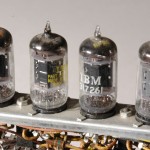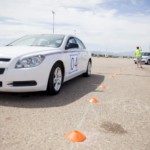 Remember when you saw those old-timey photos of room-sized vacuum-tube-powered computers , and laughed and laughed? That tech might be making a comeback, thanks to work from scientists from UC San Diego . They’ve built the first semiconductor-free, laser-controlled microelectronics device using free electrons in air, much like how vacuum tubes work. The research could result in better solar panels and faster microelectronic devices that can carry more power. Semiconductors based on silicon and other materials are great, obviously, having helped us squeeze billions of transistors into a few square inches. But they have some issues: Electron velocity is limited by the resistance of semiconductor materials, and a boost of energy is required to just to get them flowing through the “band gap” caused by the insulating properties of semiconductors like silicon. Vacuum tubes don’t have those problems, since they use free electrons in the air to carry (or not) a current. Getting free electrons at nanoscale sizes is problematic, however — you need either high voltages (over 100 volts), high temperatures or a powerful laser to knock them loose. The UC San Diego team solved that problem by building gold “mushroom” nanostructures with adjacent parallel gold strips (above). By combining a relatively low amount of power (10 volts) with a low-powered laser, they were able to dislodge electrons from the gold metal. The result was a tenfold (1000 percent) increase in conductivity in the system, a change sufficient “to realize on and off states, that is, the structure performs as an optical switch, ” according to the paper in Nature . The device can thus act as a transistors, power amplifier or photodetector, much as semiconductors do. However, it can theoretically work with less resistance and handle higher amounts of power. So far, the research is just a proof-of-concept, but it’s very promising. “Next, we need to understand how far these devices can be scaled and the limits of their performance, ” says author Dan Sievenpiper. The team aims to explore applications not just in electronics, but photovoltaics, environmental applications and, possibly, weaponry — the research was funded, after all, by DARPA. Source: UC San Diego
Remember when you saw those old-timey photos of room-sized vacuum-tube-powered computers , and laughed and laughed? That tech might be making a comeback, thanks to work from scientists from UC San Diego . They’ve built the first semiconductor-free, laser-controlled microelectronics device using free electrons in air, much like how vacuum tubes work. The research could result in better solar panels and faster microelectronic devices that can carry more power. Semiconductors based on silicon and other materials are great, obviously, having helped us squeeze billions of transistors into a few square inches. But they have some issues: Electron velocity is limited by the resistance of semiconductor materials, and a boost of energy is required to just to get them flowing through the “band gap” caused by the insulating properties of semiconductors like silicon. Vacuum tubes don’t have those problems, since they use free electrons in the air to carry (or not) a current. Getting free electrons at nanoscale sizes is problematic, however — you need either high voltages (over 100 volts), high temperatures or a powerful laser to knock them loose. The UC San Diego team solved that problem by building gold “mushroom” nanostructures with adjacent parallel gold strips (above). By combining a relatively low amount of power (10 volts) with a low-powered laser, they were able to dislodge electrons from the gold metal. The result was a tenfold (1000 percent) increase in conductivity in the system, a change sufficient “to realize on and off states, that is, the structure performs as an optical switch, ” according to the paper in Nature . The device can thus act as a transistors, power amplifier or photodetector, much as semiconductors do. However, it can theoretically work with less resistance and handle higher amounts of power. So far, the research is just a proof-of-concept, but it’s very promising. “Next, we need to understand how far these devices can be scaled and the limits of their performance, ” says author Dan Sievenpiper. The team aims to explore applications not just in electronics, but photovoltaics, environmental applications and, possibly, weaponry — the research was funded, after all, by DARPA. Source: UC San Diego
Taken from:
Scientists built a chip without semiconductors







